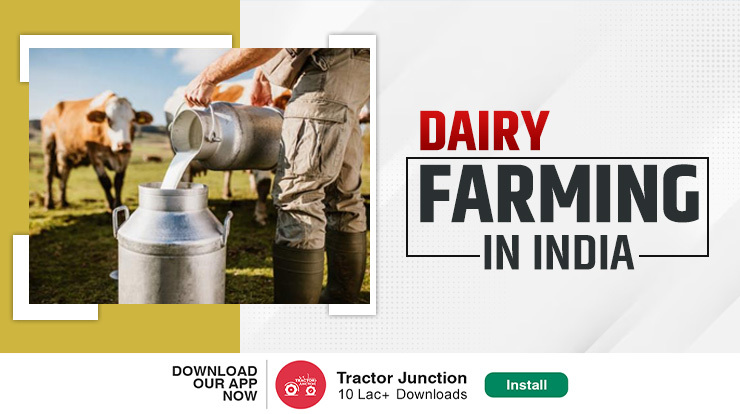
For several millennia now, dairy farming has been around globally. Animal husbandry started in the Middle East. Since then, animals have been reared for their ability to give milk. Dairy farming is a key industry as dairy products are always in demand. It also has been changed from small scale domestic farms to large scale operations. Safe to say, starting a dairy farming project has profit potential.
So What is Dairy Farming?
Dairy is a big business in India and helps the country’s economy. It makes up for 4% of the GDP and is a crucial commodity. India makes up for the most milk production in the world. As much as 188 million MT of milk came from India in 2019-20.
What’s more, Private dairy farms make up over 60% of the country’s dairy capacity. They have been an important part of the business’s growth. The Indian dairy industry has increased by 12% in the past five years.
Value-added products are also helping the industry expand. Dairy is key for farmers because nearly 70 million are in on it. Farmers receive 70-80% of the market value. So, it’s safe to say that it makes up for around a third of rural income in India.
So in this blog, let us look at the future for dairy farming in 2023.
Dairy Farming Practices

Dairy farming in India weathered the test of time through various practices. From hand milking to robotic milking, there are many types of milking. While the first suits small scale farmers, large scalers can earn well by choosing automated practices. So here’s a look at all the different dairy farming practices:
- Traditional Grazing: Cows graze on grazing land and are milked by hand or machine.
- Free stall: Cows are reared in separate stalls, with access to feed and water.
- Robotic milking: Refers to robot systems that milk cows without the need for human labour.
- Organic Farming: Cows are reared without chemicals, hormones, or drugs in organic farming.
- Grass-fed: Grass fed means that the cows are fed just grass and hay, with no grain or additives.
- Intensive Farming: High density farms that enhance milk output via regulated feeding and breeding programmes.
A detail about the economics of dairy farming
- The worldwide dairy market is enormous, valued at over $500 billion.
- Dairy products such as milk, cheese, butter, and yoghurt drive the dairy market.
- The major dairy producers are the United States, India, and China.
- India shares a huge chunk in this, as the market value is $140 billion.
- Indian small-scale farmers produce milk in their local markets. What’s more, they are the major contributors to the national dairy market.
- Per year, dairy farmers in India sell a whopping 180 million tonnes of milk. This makes India the leading producer of milk in the world!
Why Does the Dairy Market Fluctuate?
- The dairy market can easily be affected by variations in supply and demand.
- Weather conditions, prices involved, and customer needs may all impact the market.
- Moreover, trade issues and government subsidies might have an impact on pricing.
Related: Opening a Duck Farming Business In India
What are the New Trends?
Dairy farming is undergoing constant transformation and innovation.
Precision agriculture is where farmers use data to increase milk production. This, indeed, is one of these breakthroughs in dairy farming. Moreover, alternative milk products are also becoming all the rage now, such as plant based milk.
Tech also comes in handy to increase milking process efficiency and monitoring cow health.
Why Sustainable Practices?

- Dairy production may have a substantial effect.
- Greenhouse emissions, water degradation, and cutting down trees are the tip of the iceberg.
- Reduced use of synthetic fertilisers, conserving water, and using green energy sources are examples of sustainable practices.
Involvement of Technology in Sustainable Dairy
- Precision farming, biogas generation, and waste management systems are among the innovative technologies boosting dairy sector sustainability.
- These technologies have the potential to decrease environmental impact while also increasing agricultural efficiency.
Balancing dairy farming and Cattle Welfare
Governmental Intervention
- Government laws and standards are in place to preserve the well being of dairy cattle.
- They include housing, nutrition, and also medical care standards.
- Moreover, several nations have rules against animal abuse and mandate dairy farm inspections.
Practices Ensuring Cattle Welfare
Providing appropriate room and ventilation, assuring access to clean water and food, and adopting disease control measures such as immunisations are all best practices for protecting cattle health.
Farmers must also receive adequate training to maintain animal welfare.
Wrapping it up
Dairy farming has been practised for centuries and is now a vital sector with an insatiable want for dairy products.
India is the world’s biggest producer of milk, which contributes significantly to farmer income. Dairy farming strategies vary greatly, from conventional grazing to organic farming to grass-fed.
The sector is constantly developing, indeed, with technology advancements and sustainable practices driving this shift.
Related Blog
Goat Farming Project Report: Investment, Expenses & Profit
Buffalo Farming Project Report for A Dairy Farm – Cost and Profit
